by Inez J Fletcher, Cataloguer & Director of Irish ISSN Centre
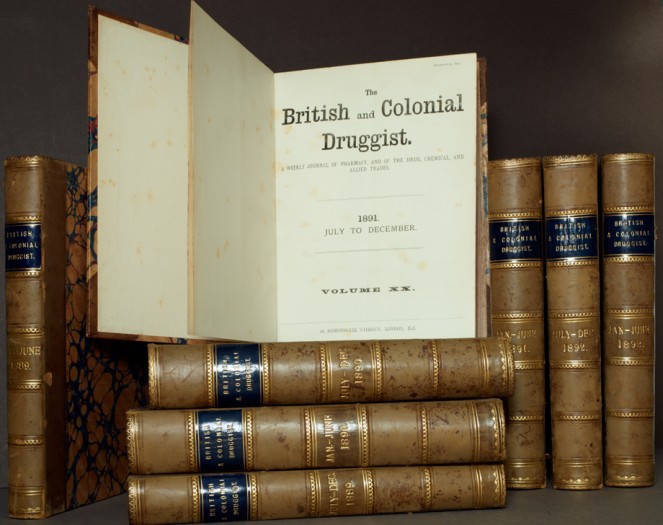
The British and Colonial Druggist, January 1889 to December 1892, in all its beautifully bound glory... NLI Ref. 1K 2182
Cataloguers come across a very wide variety of publications in the course of their regular work, but I mostly catalogue contemporary periodicals. However, recently I was asked to catalogue a run of eight volumes for the period January 1889 to December 1892 of The British and colonial druggist. These are nicely bound in marbled paper with leather spines and corner pieces, and are a recent gift from the Pharmaceutical Society of Ireland. At this period the publication is weekly, with about 48 pages per issue, and there are two volumes per year. There is substantial Irish content.
Sets of the journal seem to be rare – the only one I could find was in the British Library. It was published in London, apparently by a commercial publisher (called, unimaginatively, The British and Colonial Druggist) from 1884 to 1915 and continued as The British and colonial pharmacist (1915-51), British and overseas pharmacist (1952-57), British and overseas pharmacy and medicine (1958-60), Chemotherapy review (1960-1962), Medical observer and chemotherapy review (1961-62), where the trail appears to peter out. Genealogy is easy compared to following the twists and turns of periodical title changes, but this one is relatively simple with no splits or amalgamations. The publisher also produced handbooks and manuals, and probably retained its, by then old-fashioned, name into the 1960s.
The contents are pretty comprehensive – ranging from news from different parts of Britain and Ireland, Australia, etc., and various professional bodies, obituaries, a ‘gazette’ of dissolved partnerships and bankruptcies, current prices for ingredients, discussions on legislation, to straightforward advertisements, instructional and technical recipes, humour – anything a ‘druggist’ of the time could possibly need to know.
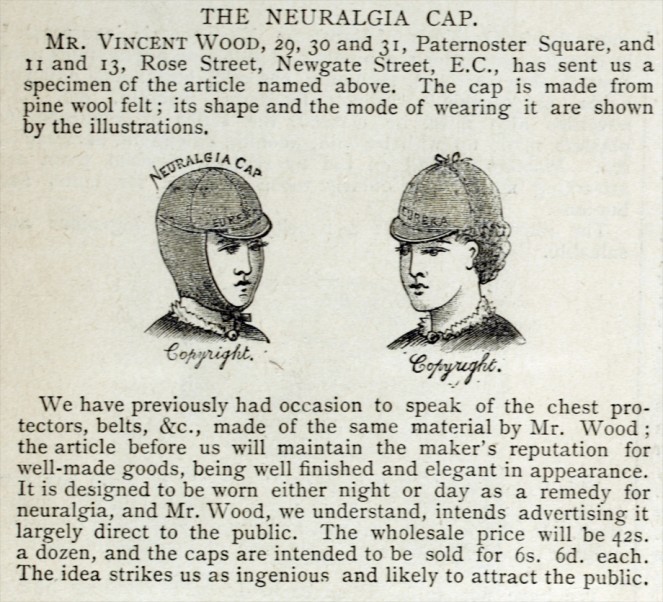
Mr Wood's Neuralgia Cap, as advertised on p. 90 of The British and Colonial Druggist (26 January 1889) was 'elegant in appearance'. NLI Ref. 1K 2182
On the first page (p. 75) of the first issue that we have (26th January 1889 – unfortunately earlier issues for that year are missing) there are advertisements for Cascara (a laxative), Kilner Glass bottles, and petroleum jelly, sanitary fluid, sheep dip and other greasy or tarry substances, along with an account of ‘THE LORD’S COMMITTEE ON THE IRISH PHARMACY ACT AMENDMENT BILL’, where the subtle differences between a chemist, a druggist and a pharmaceutical chemist and their relative qualifications are discussed. Medicines and other preparations did not come pre-prepared and packaged as they do now but generally had to be made up by the druggist/pharmacist/chemist on the premises so it was very important to be confident that the person making them up was competent to do so.
A few pages on (p. 79-81) in an article on ‘THE PREPARATION OF INFUSIONS AND TINCTURES FROM FLUID EXTRACTS’ I was intrigued by strange symbols and abbreviation, e.g. ‘ʒj’ and ‘℥ijss’. I eventually decoded ‘ʒj’ as ‘ounce’ and ‘jigger’ and ‘℥’ as ‘dram’ or ‘drachm’. The ‘ounce’ is probably an apothecary’s ounce, equivalent to a Troy ounce, used for measuring precious metals. A ‘jigger’ is a measure of volume, usually of alcohol, equal to 43 ml in modern measures. The ‘i’ and ‘ss’ have defeated me so far and I must resist the temptation to wander further through the by-ways of unusual measuring systems (including scruples and grains) and return to the main track.
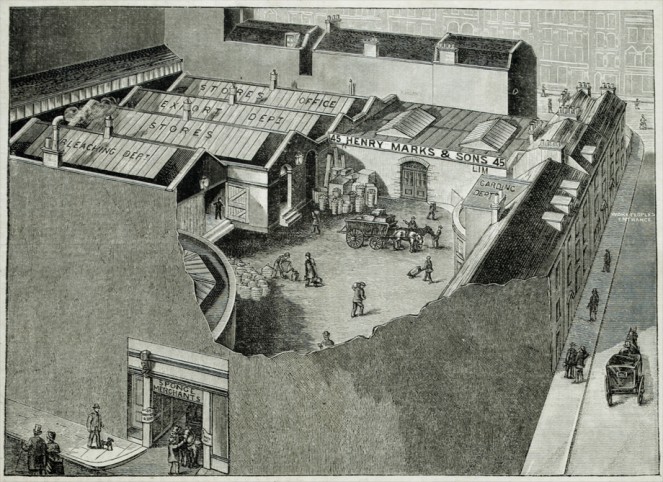
Henry Marks & Sons, Sponge Merchants of 42-45 Houndsditch, East London
This is followed (p. 82-89) by a few pages of what might be described in present-day terms as advertorials – a series of articles, complete with fine line-engravings, detailing the products and processes of ‘REPRESENTATIVE HOUSES IN THE DRUG, CHEMICAL AND ALLIED TRADES’. Coverage included a sponge importer, a manufacturer of lints etc, and a manufacturer of candles. On the same date there is an account (p. 90) of ‘A CARBOLIC ACID POISONING CASE’ – fatal – which occurred when a night-watchman drank the poison in mistake for cold tea. The gruesome symptoms, treatment and an account of the ‘necropsy’ are given in detail.
In the ‘METROPOLITAN AND PROVINCIAL NEWS’ section ‘IRELAND: DUBLIN’ (p. 95) under the caption ‘NEW NAME’ we find: ‘Messrs. M and C Bracken’s oil, colour, and chandlery business, at 115 Clanbrassil Street, has blossomed forth into the “Clanbrassil Drug and Oil Warehouse". Shakespeare was wrong, think Messrs. Bracken.' A rose by any other name... Also in the same section (p. 99): ‘The WEATHER - The weather here is very mild, and “what shall we do with our cold cream"? is wailed by many unfortunates, who have stocked it largely; while chilblain liniment is out of the question, and “Pectoral Balsam” a drug in the market. One pharmacist suggests that seasonable weather should be prayed for in churches’. This is followed by ‘ILLEGIBLE PRESCRIPTIONS.- Re some notes on illegible prescription writing in last week’s issue, it is worthy to note that it was stated at a meeting of students, held a few weeks ago in the Rotunda, that the legibility of a physician’s prescription was, in Dublin, in inverse ratio to his celebrity.’ Some things never change!
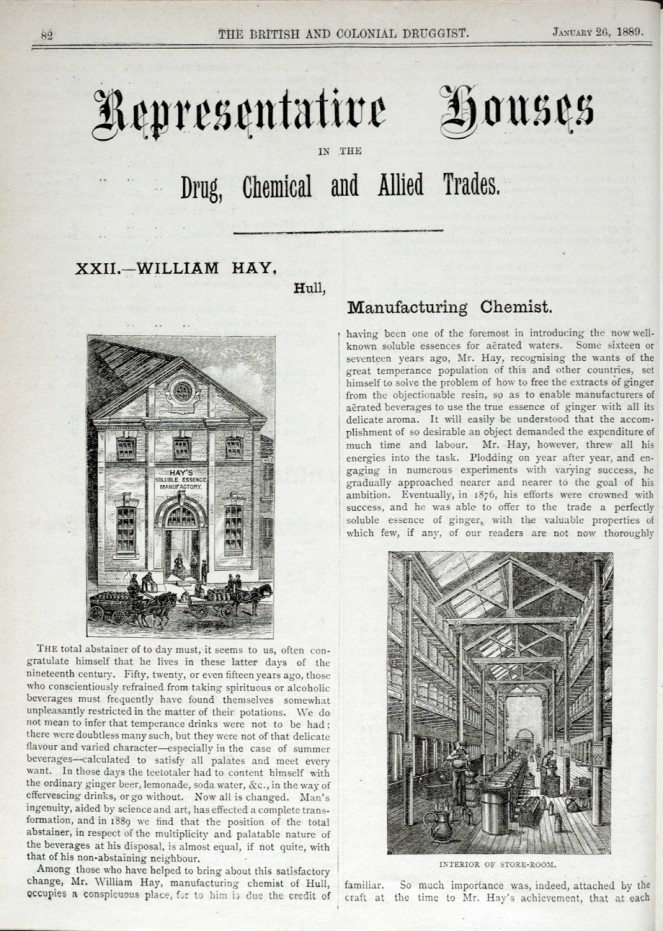
Hay's Soluble Essence Manufactory
The ‘MARKET REPORT (p. 100) (from our Special Reporter) Mincing Lane, 24 January 1889’ notes, ‘Cascara Sagrada has been improved in demand. Opium has been very quiet, and but little business passing, but holders are still very firm.’ Other substances are also listed: ‘Acids. – Citric dull of sale at 1s. 5¾d.; oxalic, 4½d.; tartaric, 1s. 3¼d . to 1s. 4d. ... Quicksilver ... Arsenic ... Ashes.- Pearl and pot ... Beeswax, Rhubarb...’.
There is also a ‘CORRESPONDENCE’ section where questions can be asked and a reply provided – ‘Legal questions will be answered by a Barrister-at-law’.
Do you remember the BBC series, The Victorian Pharmacy, in 2010? In ‘PRACTICAL NOTES AND QUERIES’ we find recipes contributed by readers for (p. 107) ‘Rat and Mice Poison’, ‘Cough Mixture’, 'Infants’ Preservative’ along with ‘Some of the Uses of Sulphurous Acid'. For the ‘Rat and Mice Poison’ the instructions are ‘Mix the [specified quantities of] strychnine and blue together, moistening with a little water; then add the cream of tartar and nux vomica. Place 10 grs. [grains] in a paper, folded as a powder, and label “Poison”; enclose in an envelope, making a 3d. package. The directions are as follows: – Sprinkle a little of the Killer on a piece of well-buttered bread, particularly round the edges, pass a knife over the surface so as to mix the Killer well with the butter, lay the bread where they frequent, and in the morning they will be found dead. Rats, being more cautious than mice, must be tempted two or three nights with the bait intended to be used'. Both the cough mixture and the ‘Preservative’ list opium among their ingredients!
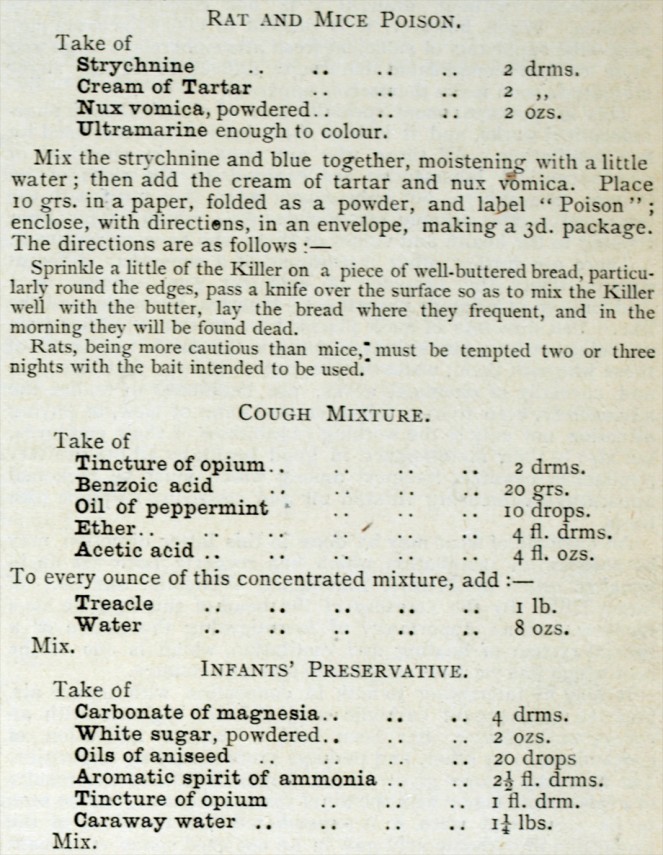
Be careful not to confuse your Nux vomica with your Oil of peppermint! Or your Treacle with your Tinture of opium!
There are also jokes – one rather feeble one, but it might have been funnier at the time, (p. 113) concerning a man who wakened a pharmacist at 3am with a trivial enquiry – and a whole page devoted to ‘CLASSICAL AND MYTHOLOGICAL PHARMACY ... Let us remember we sport in fabled stories’ which, though obviously facetious, is so laden with classical and mythological references that most modern readers, under-educated in such matters, would be baffled. Obviously a ‘druggist’ was expected to be familiar not just with the sciences but with literature and languages too.
Then comes a serious article (p. 115), almost two pages long, discussing ‘ADULTERATION AND MISREPRESENTATION’ of substances and goods and the unfairness of how those controls that exist are applied. In an article (p. 118) entitled ‘HINTS ON COMPOUNDING MEDICINES’ we find the following ‘To the inexperience of the young pharmacist there usually seems something cabalistic and mysterious about a prescription, and the experienced dispenser will acknowledge that it is not without its arcana and the secrets thereof. There are a number of seemingly insignificant, but really important points, in the practice of dispensing, which make all the difference between the mere “mixer” of galenicals and the accomplished dispenser'. Did that send you to Google or for a spin through a good old-fashioned dictionary?
There is a page (p. 121) devoted to ‘PATENTS’ – with subheadings ranging from ‘Antiseptic’, through ‘Effervescible Mixtures’, ‘Horse Medicine, ‘Musk Substitute’ to ‘Poison Bottles’ – and ‘APPLICATIONS FOR TRADE MARKS’ – one for the name ‘Cough Konckerer’ (a cough remedy, as one might expect).
As an illustration of colonial coverage, the last page (p. 122) of this issue has ‘HINTS TO EXPORTERS AND IMPORTERS’. Various countries are listed, e.g. ‘Tasmania. – New customs Tariff. ... the following articles, of more or less interest to the trade, may now be imported at the rates stated: – Acid, tartaric, per lb., £0 0s. 4d. ... Glucose, per cwt. £0 6.s 0d. ... Vinegar, per gall. £0 0s. 9d. ... The following articles are imported duty free: – ... Bluestone, ... Lampblack, ... Stearin, ... Sumac, ...’.
And that’s a summary of only one issue!

No well-appointed home would be complete without The Dentoilette
Flicking through the rest of that volume at random :
11 May (p. 473): DUBLIN.: ‘DYNAMITE. – Mr.Samuel Boyd, of 46 Mary St, is doing a large trade in Nobel’s dynamite. I understand he received a large consignment a few days ago.
PHARMACEUTICAL THESPIANS. – It is current that the assistants in a city drug firm have formed an amateur dramatic club, and will at no distant date produce their maiden effort in the Thespian line'.
1 June (p. 560): ‘The average baby ought to be thankful that its father is not an inventor. When Mr. Edison’s infant daughter crows with delight, when she screams, every sound that comes from her lips is registered on the phonograph. He means to treasure the record till she grows up, and then let loose her infant utterances. The good man thinks it will amuse her!’
11 June (p. 580): ‘NOVELTIES AND SPECIALITIES.: DETECTIVE CAMERAS. ... Dr. Krugener’s Patent Book Camera, as its name implies, is in the form of a book. It is manufactured of black vulcanite, and impressed and finished as an ordinary binding. It is made to carry twenty-four dry plates. ... The Parcel Detective Camera is box-shaped, and neatly covered with linen-lined brown paper, and tied with string like an ordinary parcel. ...’ There are no dimensions given but they can hardly have been small, were almost certainly heavy, and from the instructions given, must have been cumbersome to operate.
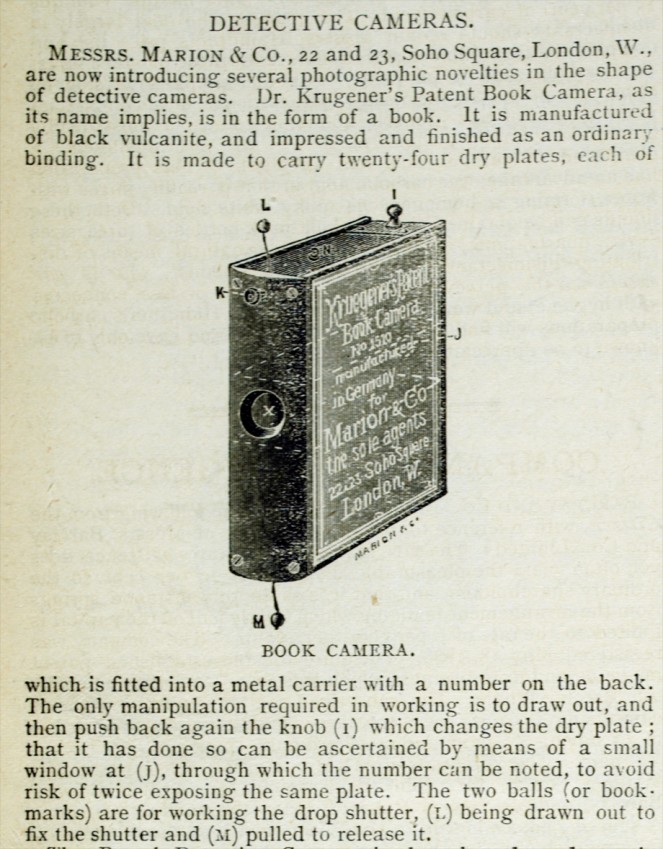
Dr. Krugener's Patent Book Camera - for industrial espionage? Divorce cases? Peeping Toms?
Comparing these volumes with modern publications, especially trade publications, I can only marvel at the quantity, quality and variety of their content – especially considering that issues were substantial and appeared weekly, – admire the often dry wit and erudition of the editor(s), the typefaces used, and the skills of the typesetters, proof readers (I’ve spotted no spelling mistakes so far) and engravers. I have found these volumes fascinating to dip into, as they have the potential to lead me down so many by-ways, chasing words and events, and comparing and contrasting the past with the present. I hope you will find them entertaining, and educational too, as they were apparently intended to be.